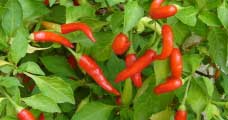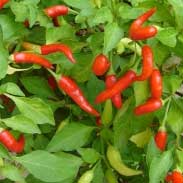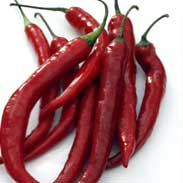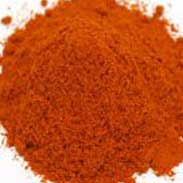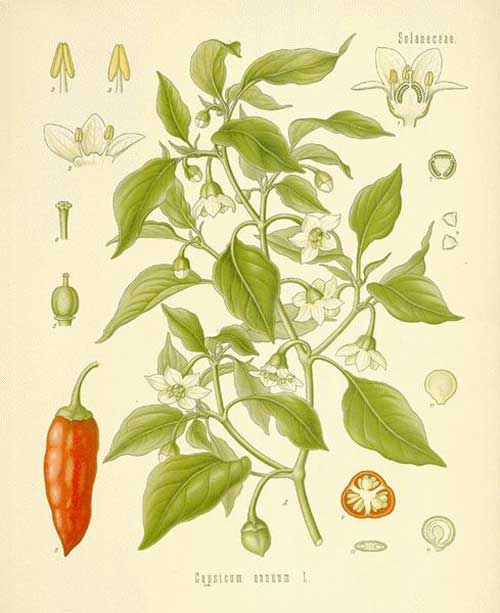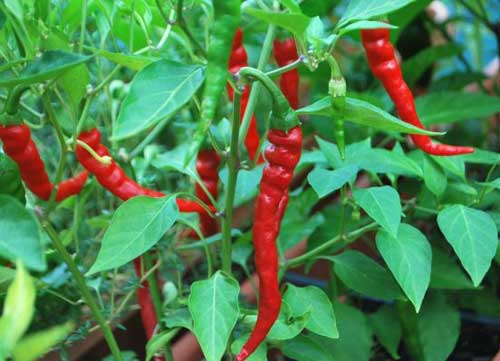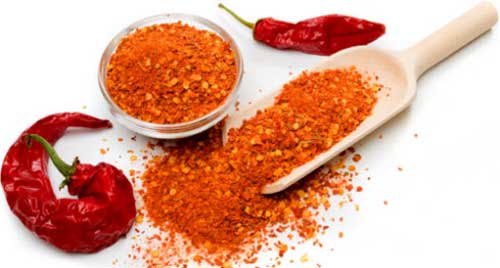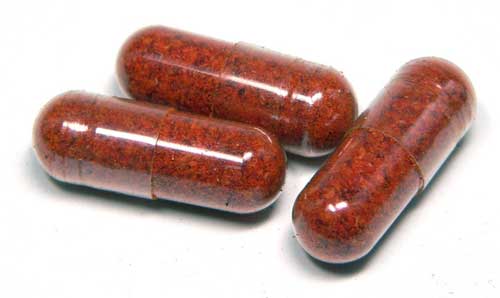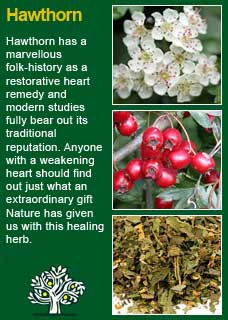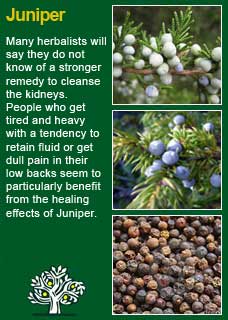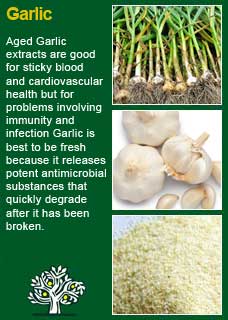
|
|
||||
| Our Pages ABOUT CONSTITUTIONAL MEDICINE
|
In herbal medicine, as in food, we use the ripe red fruits of the Cayenne plant that, so long as it gets plenty of moisture and a hot climate, can grow to a meter tall in as little as three months and then produce an abundance of spicy, potent peppers.
Cayenne is a powerful stimulant to the circulation. People who are suffering from ‘cold’ conditions such as reduced vitality, impaired blood flow, sluggish digestion, or even simply feeling too cold can all potentially benefit from Cayenne. It has been used in all kinds of folk-remedies for colds and flus', aching muscles, weakened heart health etc. From King's Dispensatory, Capsicum is a pure, energetic, permanent stimulant. Capsicum meets the debility of young and old, but is particularly useful in old people when the body-heat is low, vitality depressed, and reaction sluggish. Tired, painful muscles, stiffened joints, and relaxation of any part are common conditions in the elderly that are, in a measure, rectified by capsicum. Capsicum may be used wherever a pure stimulant is indicated, in all cases of diminished vital action, and may be combined beneficially with other remedies' TJ Lyle writes 'Cayenne is the most powerful and persistent heart stimulant known. It increases arterial force, enlarges its calibre, and slightly increases its frequency. Its influence is permanent and reaches every organ through its primary influence upon the circulation - the heart first, then the arteries, the capillaries and the nerves' F Ellingwood writes 'Cayenne produces an increase of tone and a marked and comfortable sensation of warmth in the entire system, and a glow and sensation of increased nerve influence and more active circulation. The general or systemic influence is better obtained from the tincture or from the hot infusion, while local stomach or intestinal effects follow promptly upon the administration of the powder. WM Cook writes 'Cayenne is one of the purest of all known stimulants, of great intensity, very permanent in its action, spreading through the system rather slowly, but ultimately reaching every organ of the frame. It creates a sensation of warmth, and finally of biting pungency, in the mouth, stomach, skin, or other part to which it is directly applied. The British Herbal Pharmacopoeia (BHP) describes the actions of Cayenne as 'stimulant, spasmolytic, carminative, diaphoretic' and says it is indicated for 'flatulent dyspepsia in the absence of inflammation, colic, insufficiency of peripheral circulation, chronic laryngitis as a gargle. External use - neuralgia, rheumatic pains, unbroken chilblains' and specifically indicated for 'atony of the digestive organs especially in debility of age, as an adjuvant in the treatment of the debilitated. Topically - lumbago (as a lotion) unbroken chilblains (as lotion or ointment) The BHP recommends doses of 0.06-0.2 mls (1-3 drops) or 30-120mg of the dried herb. Thomas Bartram writes on the action of Cayenne that it is 'regarded by the professional herbalist as the purest and safest stimulant known. Opens up every tissue in the body to an increased flow of blood. Produces natural warmth, equalising the circulation in the aged. It accelerates oxygenation of cells. Antiseptic, carminative and antispasmodic for the relief of pain. Well suited to persons of feeble constitution with poor circulation, lacking in energy and fear of the slightest draft. He suggests uses for it including poor digestion in the aged, wind, nervous depression, impotency, to increase gastrointestinal secretion and thus improve the appetite; a mere pinch (1/8th of a tsp) may suffice'
~ Several clinical studies show that topically applying cream containing 0.05% to 0.075% capsaicin, the active constituent in Cayenne, temporarily relieves chronic pain from rheumatoid arthritis, osteoarthritis, back pain, jaw pain, psoriasis, and neuropathic conditions (Mason L, Moore RA, Derry S, et al. Systematic review of topical capsaicin for the treatment of chronic pain. BMJ 2004;328:991) (Basha, K. M. and Whitehouse, F. W. Capsaicin: a therapeutic option for painful diabetic neuropathy. Henry.Ford.Hosp.Med.J. 1991;39(2):138-140) ~ Clinical research shows that applying a capsicum-containing plaster to the back can significantly reduce low-back pain compared to placebo (Gagnier JJ, van Tulder MW, Berman B, Bombardier C. Herbal medicine for low back pain. A Cochrane review. Spine 2007;32:82-92) (Frerick H, Keitel W, Kuhn U, et al. Topical treatment of chronic low back pain with a capsicum plaster. Pain 2003;106:59-64) Human studies with Cayenne have shown that it markedly decreased the nasal congestion of patients with chronic rhinitis when given in a one month trial (Marabini S, Ciabatti PG, Polli G, et al. Beneficial effects of intranasal applications of capsaicin in patients with vasomotor rhinitis. Eur Arch Otorhinolaryngol 1991;248:191-4) (Blom HM, Van Rijswijk JB, Garrelds IM, et al. Intranasal capsaicin is efficacious in non-allergic, non-infectious perennial rhinitis. A placebo-controlled study. Clin Exp Allergy 1997;27:796-801) ~ Cayenne has been shown to interact with a prostaglandin involved in pain transmission called substance 'P' and studies have shown that Cayenne decreases pain in patients suffering from nerve pain in their lower backs (Gagnier JJ, van Tulder MW, Berman B, Bombardier C. Herbal medicine for low back pain. A Cochrane review. Spine 2007;32:82-92) ~ Numerous other studies have shown the mechanism of action of capsaicin with respect to its pain-relieving propertyies and this action is the subject of many reviews (Calixto, J. B., Beirith, A., Ferreira, J., Santos, A. R., Filho, V. C., and Yunes, R. A. Naturally occurring antinociceptive substances from plants. Phytother.Res. 2000;14(6):401-418) ~ European studies have shown that adding Cayenne pepper to meals has a stimulating effect on brown fat thermogenesis enabling the body to burn off more fat for metabolic energy rather than storage (Reinbach, H. C., Smeets, A., Martinussen, T., Moller, P., and Westerterp-Plantenga, M. S. Effects of capsaicin, green tea and CH-19 sweet pepper on appetite and energy intake in humans in negative and positive energy balance. Clin Nutr. 2009;28(3):260-265) ~ Meyer-Bahlburg et al. conducted pilot studies on stimulant effects of Capsicum spices and found it bought about improvements in the ability to concentrate (Meyer-Bahlburg, H. F. Pilot studies on stimulant effects of capsicum spices. Nutr.Metab 1972;14(4):245-254) ~ In human research, cayenne supplementation for five weeks resulted in decreased symptoms associated with indigestion and dyspepsia (Bortolotti M, Coccia G, Grossi G, Miglioli M. The treatment of functional dyspepsia with red pepper. Aliment Pharmacol Ther 2002;16:1075-82) ~ The effects of a Cayenne based cream has been tested on 45 patients with chronic cluster headaches. The patients had to put some of the cream inside the nostril on the same side as the headache and then the nose had to be gently massaged for 15 seconds to make sure the cream was evenly distributed. Headaches vanished in 34 of the 45, 5 others got a 50% improvement and only 6 had no response. The expected side effect of mild burning in the nose was well tolerated and it was noticed that subsequent applications produced less discomfort (Rapoport AM, Bigal ME, Tepper SJ, Sheftell FD. Intranasal medications for the treatment of migraine and cluster headache. CNS Drugs 2004;18:671-85) (Fusco BM, Marabini S, Maggi CA, et al. Preventative effect of repeated nasal applications of capsaicin in cluster headache. Pain 1994;59:321-5) ~ Capsaicin (the active 'hot' ingredient in Cayenne) has been found to first stimulate and then to desensitise the warmth detectors in the hypothalamus gland, so that a drop in body temperature is evident. This phenomenon and the plentiful consumption of peppers enables people in such hot countries as Africa and Central America to actually tolerate the heat better by keeping themselves cooler. The New England Journal of Medicine reports that residents of Thailand have virtually no blood clot problems because of their high consumption of Cayenne. ~ The authors, titles and the 'where-and-when' published of nearly 300 further studies and articles on Cayenne are listed in a PDF found here
Too much of anything can be a bad thing however and excess use of Cayenne may cause an overstimulation of the digestive tract. This said we again see the great paradox of Cayenne in that it has been used to treat stomach ulcers (the herb causes a reflex coating over the gut due to the increased secretions which can help the ulcer to heal). It is a very safe herb so long as it used wisely.
For some years now, against this proven and safe way of herbalism, there has been a rising tide of excessive caution and scare-mongering in many parts of the world. The same authorities that, not so long ago, decried herbal medicines as ineffectual, have now taken up a different adversarial position; that they are dangerous substances that should only be prescribed by Doctors, who of course have zero training in them. Unfortunately, the same unnecessary fear and worry has crept into many natural health websites and popular publications on herbs. Herbs that we have safely used for thousands of years, that have no reports of adverse reactions in the medical literature despite widespread use by millions of people, are suddenly described as contraindicated because of something that should have been seen as completely unimportant, or at the utmost a merely theoretical concern, such as a laboratory study on one of the herb's constituents to use an all too common example. I wonder sometimes if the writers of such articles feel that the herb will be more deserving of respect if it is thought to be a little bit dangerous, in other words more like a drug than something that has simply come out of the earth and been used by ordinary people for generations beyond count. There is just so much misinformation about herbal medicine on the internet now. Ludicrous claims and cautions abound in equal measure; it seems like one group are trying to make money out of the public whilst the other are busily trying to scare them off. I have to believe that the kind of reader who takes the time to read pages on herbs that are as extensive as this one is much less likely to be swayed by marketers or misinformers. I hope that you will keep your wits about you if you get conflicting opinions from people who have never really got to know these herbs, who have never worked with them, or learned how to use them safely and effectively. I want to remind you that the reason that herbs can never be patented and owned by any individual or corporation is because they are, and always will be, the People's medicine. They belong to all of us and it is my great hope in sharing this work that you will learn how to use them wisely for yourself, and the people you care for. Be safe, but do not be afraid.
I have used a lot of Cayenne in external applications to people with chronic pain, especially in their lower back or their knee or hip joints. Rubbing in some tincture of Cayenne causes a tremendously deep and penetrating heat that can help to shift a condition that may have been stuck for months if not years. I have also used Cayenne plasters that stay on the affected area for 8 hours or more for the same purpose. Cayenne can improve a weakened circulation and for many people its help has been the turning point for their health. The Chinese understand the vital ‘chi’ or life force, to follow the blood and only when the blood flows evenly and abundantly can there truly be good health. When I want to get a strong effect from this great herb then I use a lot of Cayenne in capsule form. Typically, this is for people for whom I want to warm their constitution, help their blood flow more freely or reduce their pain. To be honest the only way to know for sure whether Cayenne can really help is by taking a 'try and see' approach so if this is something you do want to try then you have to be crystal clear on the vital matter of the dose. I cannot advise you on a product without seeing you in person but as a general guide for the Cayenne capsules that we use in our clinic I usually start a person on 1 or 2 capsules, usually twice a day but maybe just once a day if we want to proceed very cautiously, and then advise them to see how their body feels with it and to be prepared to add a capsule every few days to see if they get an improved effect or whether their body tells them it has had enough. The maximum dose we get to is 4 capsules twice a day. The gradual build-up of the dose is both to check for tolerance, if you are taking too much you then you will get some excess feelings of 'heat' in your body. This may be a literal feeling of being too hot or it may feel like a kind of agitation, like you are being too stimulated. If this happens it does not necessarily mean it is the wrong herb for you, just that you are having a little too much of it. Go back to a smaller dose but be prepared to try using a larger dose again after at least a few days. Cayenne is a herb that people can get used to but you should not rush it. I have in the past sometimes used a tiny dose of Cayenne in a liquid formula but you must be terribly careful not to overdo this or the whole mixture becomes too hard to use. About 2 or 3 mls in a 200ml bottle is about the maximum. Even at the lowest of doses, because of too many patients having difficulties taking a medicine with Cayenne in it in a liquid form, I now exclusively use the capsules for internal use. Cayenne combines exceptionally well with Hawthorn for people with poor circulation or a weak heart and it can also work perfectly with Juniper berry and/or Garlic for sticky blood.
Cayenne may be used in an incredibly potent throat gargle but be warned, this is not for the faint-hearted! This is a recipe from Dr Jane Guiltinan, chief medical officer at the John Bastyr University Natural Health Clinic in Seattle. Jane says 'this will literally knock the socks off the worst sore throat pain imaginable'. Take half a glass of warm water, add half a squeezed lemon, a tablespoon of salt and half a teaspoon of Cayenne pepper. Gargle small amounts for as long as you are able, spit out and do not swallow. Honey, vanilla extract or maple syrup may certainly be added to improve the horrible taste. The pain relief should last for about four hours before you may need to repeat the treatment.
Much of the information here about the traditional uses of Cayenne is consistent with the model of thinking whereby one may treat problem A with plant B. There is value in this approach, especially in how it helps us pass on useful knowledge to one another, but it falls short in one vital area; and that is that people are not all cut from the same cloth! Something that works brilliantly for one person may do less for another -- why is this? Part of the reason is that people vary in their constitutions as to whether they are either hotter or cooler and, at the same time, either dryer or damper. This useful and rather fascinating subject is introduced further here Another big part of using the right herb when it is most needed comes from understanding the need to treat what is going wrong for the person that had led up to their getting a health condition. In this light, Cayenne can particularly offer its benefits when activation is needed in the 'cycle of healing', more about this here
Please understand that I cannot advise you, including on products or dosage, without seeing you in person in my clinic but for ideas
on how you might find a good herbalist in your area read here |
|
|
© 2011 R.J.Whelan Ltd
